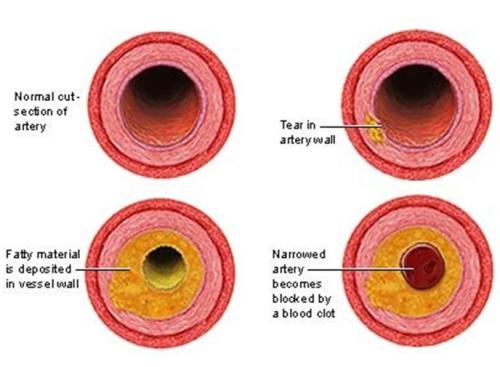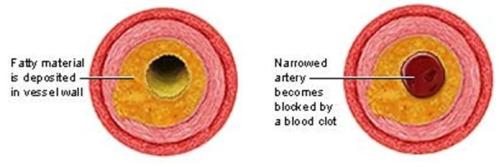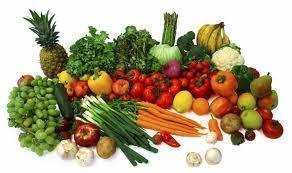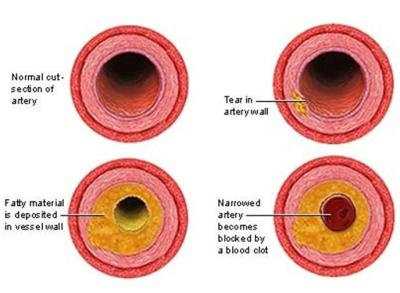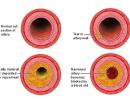
|
High Cholesterol (Hypercholestrolemia)
|
| Introduction | Prevention and treatment | |||
| Causes of High Cholesterol | Review Process | |||
| Symptoms of High Cholesterol | Information Source Links |
Introduction
|
What is high cholesterol?
Cholesterol is a waxy, fat like substances, called a lipid (blood fat). It is produced in the liver. The body needs cholesterol to manufacture cell membranes, hormones and Vitamin D. Increase in dietary cholesterol increases the cholesterol in the blood. High cholesterol has come to be known as the silent killer because it is often the first symptom to be experienced and often also the last before a fatal heart attack. In the correct quantities, cholesterol is essential for health and wellbeing. But when cholesterol levels get too high, excess cholesterol becomes trapped in artery walls reducing blood flow to the heart and causing a heart attack
Types of cholesterol
LDL Low density Lipoprotein (Less than 130mg/dL)
LDL is referred to as "bad" cholesterol. High levels may form fatty deposits in the arteries.
HDL; High Density Lipoprotein (Greater than 60mg/dL)
HDL is known as the "good" cholesterol; it helps to remove excess LDL from the blood stream.
Triglycerides; (less than 150mg/dL)
Transport Fat in the Blood Stream. You probably know your blood pressure, cholesterol level and maybe even your blood sugar - but what about your triglyceride level? While they get less attention than cholesterol, triglycerides are significantly linked to heart disease.
Triglycerides are the main form of fat found in foods, whether they are saturated, polyunsaturated or monounsaturated. Excess calories are converted to triglycerides for storage as body fat.
Triglycerides in your blood are usually higher if you are overweight, consume too much alcohol, refined sugars or when diabetes is out of control. A high blood triglyceride level (above 150 mg/dl) is a risk factor for heart disease, so it is a must to monitor your level regularly.
The risk of developing heart disease increases as total blood cholesterol, LDL and triglycerides levels rise. Chances of developing heart disease are further increased if there are additional risk factors present e.g. diabetes, high blood pressure among others.
|
|
Causes of High Cholesterol
The amount of blood cholesterol is influenced primarily by diet, hereditary factors, and diseases such as diabetes. Smoking, obesity, lack of exercise, stress and high blood pressure (hypertension) can also contribute to high cholesterol. In general blood cholesterol levels tend to rise with age.
Cholesterol is obtained from animal sources such as dairy, beef, pork, poultry egg yolks, organ meats and lamb products and consumption of saturated fat intake, such as butter, ghee, fatty parts of meat, chicken skin.
Trans fats also decrease HDL and may be involved in arrhythmias and sudden hearts attack. Trans fats are found in baked foods, processed foods (sausages, bacon, salami, frankfurters, etc) and shortening.
High consumption of sugars, processed foods, alcohol and general starch will increase your triglycerides, which in turn increases your risk of heart disease.
Symptoms of High Cholesterol
|
High cholesterol poses a risk of many health problems such as diabetes due to insulin insensitivity, high blood pressure due to blockage of the arteries, and heart attacks. Some of the symptoms associated with high cholesterol include:
|
|
| Normal | 3.88-4.88 | Good |
| Raised | 4.88-6.1 | Borderline, see a dietician for nutrition education and change diet and lifestyle |
| High | 6.13 and above | High. Must see a dietician, for effective management |
Prevention and treatment
Diagnosing high cholesterol
A laboratory blood test is necessary to give an accurate indication of cholesterol levels. Generally a blood sample is taken from the arm, after the patient has fasted (gone without food) for at least 12 hours. In some cases, an automated system may be available, which can test a sample from a single pinprick of the finger.
|
Treatment and management
For those people with an inherited tendency towards high level of cholesterol, in the blood, lipid lowering drugs may be recommended. This may also apply with a pre-existing condition such as diabetes. A change of lifestyle may also be required to accompany any drug treatment
Management of cholesterol
Low cholesterol is maintained by:
|
|
Review Process
1. Draft supplied by Alice Ndong
2. Formatting and updating by Infonet March 2011
3. Review by Dr Alice Ndong February 2012
2. Formatting and updating by Infonet March 2011
3. Review by Dr Alice Ndong February 2012
Information Source Links
- Holford, Patrich 2007: New Optimum Nutrition Bible. Piatkus books www.piatcus.co.uk , An imprint of Little, Brown book group, 100 Victoria Embankment, London EC4Y ODY. ISBN No: 978-0-7499-2552-9. Available in Kenya through the Health Food shops
- Phylis A. Balch, and James F Balch, Prescription fro Nutritional healing, 3rd Edition.
- highcholesterolfoodsblog
- runthreeseven.wordpress.com

 Back
Back
